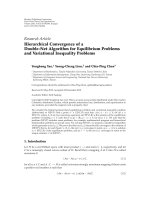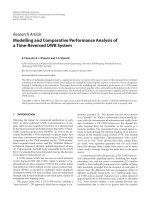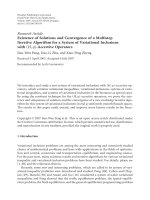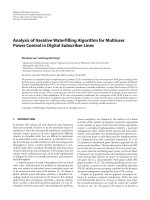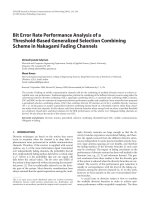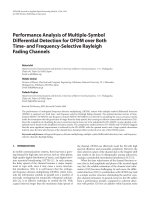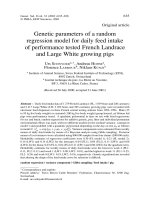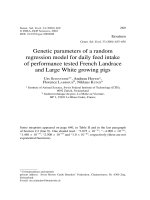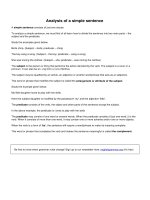Performance analysis of a random search algorithm for distributed autonomous mobile robots
Bạn đang xem bản rút gọn của tài liệu. Xem và tải ngay bản đầy đủ của tài liệu tại đây (1.4 MB, 156 trang )
PERFORMANCE ANALYSIS OF A RANDOM SEARCH
ALGORITHM FOR DISTRIBUTED AUTONOMOUS
MOBILE ROBOTS
CHENG CHEE KONG
(B.Eng.(Hons.), NUS)
A THESIS SUBMITTED
FOR THE DEGREE OF MASTER OF ENGINEERING
DEPARTMENT OF MECHANICAL ENGINEERING
NATIONAL UNIVERSITY OF SINGAPORE
2004
Acknowledgements
Acknowledgements
Firstly, I would like to express my heartfelt appreciation to my project supervisor,
Associate Professor Gerard Leng. This project will never be realised without his
commendable guidance. Since my Bachelor’s dissertation project until this Master’s
dissertation project, he has always been there to guide me. Particularly in this Master’s
dissertation project, he has provided me with tremendous assistance in finding my
project focus. Despite his busy schedules, he has relentlessly met me at least once a
week to obtain updates on the project progress and to ensure that I am progressing in
the right direction. He is praiseworthy for his patience in listening to the problems
faced during the course of the project and providing valuable suggestions to solve
them. Also, not forgetting him for all the birthday parties he has initiated for the
postgraduate students, and the many lunches that he has treated us.
Next, I would like to thank my fellow peers, Mr Low Yee Leong and Mr Ng Wee Kiat
for their remarkable support and help in making this project a success. Throughout the
course of this project, they have provided me with a lot of valuable recommendations
and insights when formulating the search algorithm and building the robots.
I would also like to express my earnest gratitude to Mr Cheng Kok Seng, Amy, Mr
Ahmad and Pricilla from the Dynamics and Vibration Laboratory, for the generous
help that they have rendered.
In addition, I extend my gratitude to DSO National Laboratories for sponsoring part of
the project and my DSO colleagues, Mr New Ai Peng and Mr Yeo Ye Chuan for
i
Acknowledgements
sharing their views with me. I further thanked Mr Yeo for lending me the workstations
to run my simulations.
My family and friends have played important roles in my studies.
Their
encouragement, concern and support are more than meaningful and heartfelt.
ii
Table of contents
Table of Contents
ACKNOWLEDGEMENTS ..........................................................................................I
TABLE OF CONTENTS .......................................................................................... III
SUMMARY .................................................................................................................VI
LIST OF FIGURES .................................................................................................VIII
LIST OF TABLES ....................................................................................................... X
CHAPTER 1:
INTRODUCTION............................................................................. 1
1.1
BACKGROUND .................................................................................................. 1
1.2
PROJECT OBJECTIVES ....................................................................................... 3
1.3
PROBLEM DEFINITION ...................................................................................... 7
1.3.1
Mobile Robot........................................................................................... 7
1.3.2
Target...................................................................................................... 8
1.3.3
Search Environment................................................................................ 8
1.3.4
Possible Applications.............................................................................. 9
1.4
OUTLINE ........................................................................................................ 10
CHAPTER 2:
2.1
2.2
2.3
2.4
2.5
2.6
BACKGROUND ON PREVIOUS WORK .................................. 12
APPROACHES TO MULTI-ROBOT CONTROL .................................................... 13
ROBOT CONTROL ........................................................................................... 17
COMMUNICATION .......................................................................................... 18
SEARCH STRATEGY ........................................................................................ 19
RELATED WORK ............................................................................................ 20
CHAPTER SUMMARY ...................................................................................... 21
CHAPTER 3: DESIGNING THE MULTI-ROBOT SYSTEM
ARCHITECTURE...................................................................................................... 23
3.1
ARCHITECTURE REQUIREMENTS .................................................................... 23
3.2
INSPIRATION FROM NATURE .......................................................................... 24
3.3
PROPOSED ALGORITHM ................................................................................. 26
3.3.1
Algorithm Characteristics..................................................................... 28
3.3.2
Uniqueness of Algorithm....................................................................... 29
3.4
CHAPTER SUMMARY ...................................................................................... 30
CHAPTER 4:
DESIGNING A PHYSICAL ROBOT PLATFORM................... 31
4.1
MOBILE ROBOT DESIGN CRITERIA ................................................................. 31
4.2
INSPIRATION FROM NATURE .......................................................................... 32
4.3
ROBOT PLATFORM DESCRIPTION ................................................................... 33
4.3.1
Features of CoSyBot ............................................................................. 35
4.3.1.1 Physical Structure ............................................................................. 35
4.3.1.2 Mobility............................................................................................. 35
4.3.1.3 Sensors .............................................................................................. 36
4.3.1.4 Communication................................................................................. 37
4.3.1.5 Processing ......................................................................................... 38
4.4
CLIENT PROGRAM .......................................................................................... 39
4.4.1
Features of the Client Program ............................................................ 41
iii
Table of contents
4.5
CHAPTER SUMMARY ...................................................................................... 42
CHAPTER 5: MODELLING THE PHYSICAL ROBOT AND STRUCTURED
ENVIRONMENT........................................................................................................ 44
5.1
COSYBOT SIMULATION ................................................................................. 44
5.2
MODELLING THE COSYBOT ........................................................................... 45
5.2.1
Physical Body........................................................................................ 45
5.2.2
Motion Drive......................................................................................... 46
5.2.3
Sensors .................................................................................................. 46
5.2.4
Communication ..................................................................................... 47
5.3
MODELLING TARGET ..................................................................................... 49
5.4
MODELLING THE STRUCTURED ENVIRONMENT ............................................. 49
5.5
INPUT FILE ..................................................................................................... 49
5.6
CHAPTER SUMMARY ...................................................................................... 50
CHAPTER 6:
ALGORITHM IMPLEMENTATION.......................................... 51
6.1
MOBILE ROBOT NAVIGATION ........................................................................ 51
6.2
REACTIVE BEHAVIOURS................................................................................. 53
6.2.1
Obstacle Avoidance .............................................................................. 55
6.2.2
Target Detection ................................................................................... 60
6.2.3
Respond to Neighbouring Robot’s Message ......................................... 63
6.2.4
Follow External Commands ................................................................. 66
6.2.5
Wander.................................................................................................. 66
6.3
IMPLEMENTING THE REACTIVE BEHAVIOURS ................................................ 68
6.4
CHAPTER SUMMARY ...................................................................................... 70
CHAPTER 7:
ANALYSING THE SYSTEM PERFORMANCE ....................... 72
7.1
TESTING THE ALGORITHM IN SIMULATION .................................................... 72
7.1.1
Experiment Set-up................................................................................. 73
7.1.1.1 Results and Analysis ......................................................................... 73
7.2
PHYSICAL EXPERIMENTS ............................................................................... 75
7.2.1
Experiment Set-up................................................................................. 76
7.2.2
Robots Searching for Targets ............................................................... 76
7.2.3
Physical Experiments Results and Observations.................................. 81
7.2.4
Comparing with Simulated Test Results ............................................... 82
7.3
SIMULATION EXPERIMENTS ........................................................................... 83
7.3.1
Varying the Number of Robots.............................................................. 83
7.3.1.1 Experiment Set-up ............................................................................ 84
7.3.1.2 Results and Analysis ......................................................................... 84
7.3.2
Varying the Starting Positions and Targets’ Positions......................... 86
7.3.2.1 Experiment Set-up ............................................................................ 86
7.3.2.2 Results and Analysis ......................................................................... 87
7.3.3
Increasing the Environment Size .......................................................... 89
7.3.3.1 Experiment Set-up ............................................................................ 89
7.3.3.2 Results and Analysis ......................................................................... 90
7.4
DISCUSSIONS.................................................................................................. 93
7.5
CHAPTER SUMMARY ...................................................................................... 96
CHAPTER 8:
8.1
8.2
CONCLUSIONS ............................................................................. 98
DISSERTATION CONCLUSIONS ........................................................................ 98
FUTURE DIRECTIONS.................................................................................... 100
iv
Table of contents
CHAPTER 9:
REFERENCES.............................................................................. 101
APPENDIX A: DEVANTECH SRF08 SENSOR................................................... 109
APPENDIX B: BRAINSTEM GP 1.0 ..................................................................... 110
APPENDIX C: SFR08 EXPERIMENTS................................................................ 111
APPENDIX D: SIMULATION RESULTS ............................................................ 112
v
Summary
Summary
Part of the work documented in this dissertation is described in [15]. The paper has
been presented in the 2004 IEEE International Conference on Intelligent Robots and
Systems (IROS) held at Sendai in Japan.
In this project, there are two objectives.
The first objective is to formulate an
algorithm for multiple mobile robots to cooperatively search for multiple static targets
in an unknown structured environment. The environment is unknown to the robots as
they have no a priori map information on the environment layout.
The second
objective is to analyse the system performance of the proposed algorithm.
To fulfil the first objective, we formulated a distributed random search algorithm for a
team of autonomous, simple robots. The algorithm is based on five simple behavioural
rules and each robot has the same rule set. The algorithm does not need the robots to
have self-localization capabilities.
In this way, we do not have to deal with
localization problem, which is inherent and difficult to solve in the real world.
The algorithm has been implemented on physical robots. It is implemented as five
reactive behaviours on the physical robots. In the physical experiments, we deployed
five robots to search for three targets located in different rooms in a 4m by 4m mockup indoor environment with multiple rooms. Ten physical experimental runs are
repeated using the same set-up. The robots were able to find all the targets for all ten
runs. The mean time taken was 249 seconds. We also performed experiments varying
vi
Summary
the environment layout and showed that our algorithm is robust to changes in
environment layout.
In addition to physical experiments, we performed multiple simulation experiments to
analyse the system performance. The time taken for all targets to be found is used to
measure performance. In the simulation experiments, we varied the number of robots
from four to twenty robots. We also changed the robots’ starting positions and target
positions, and the size of the environment. One hundred runs are repeated for each
parameter change. Our experiment results show that increasing the number of robots
in the robot team and using robots that are smaller in size improves system
performance.
Finally, we formulated a benefit function that takes into account cost considerations to
evaluate the benefit of increasing the number of robots. We found that ten robots is the
optimal number of robots to search in an environment approximately four times the
target sensing range for the type of sensors used.
vii
List of figures
List of Figures
FIGURE 1-1: AN EXAMPLE OF A SIMPLE CLUTTERED ENVIRONMENT ................................ 5
FIGURE 1-2: AN EXAMPLE OF A STRUCTURED ENVIRONMENT .......................................... 6
FIGURE 4-1: COSYBOT ROBOT PLATFORM ..................................................................... 34
FIGURE 4-2: COSYBOT ACTUATOR LAYER ..................................................................... 36
FIGURE 4-3: SRF08 SENSORS ARRANGEMENT ................................................................ 37
FIGURE 4-4: ARCHITECTURE OF COSYBOT .................................................................... 39
FIGURE 4-5: ARCHITECTURE OF COSYBOT CLIENT PROGRAM ....................................... 41
FIGURE 4-6: GUI OF THE CLIENT PROGRAM. MAIN WINDOW (LEFT) & HARDWARE
DIAGNOSTIC WINDOW (RIGHT) ............................................................................... 42
FIGURE 5-1: SRF08 SONAR PATTERN GRAPH ................................................................. 48
FIGURE 5-2: SIMULATOR GUI........................................................................................ 50
FIGURE 6-1: (A) PLAN-BASED APPROACH VERSUS (B) LOCAL REACTIVE APPROACH ...... 54
FIGURE 6-2: SECTOR REPRESENTATION OF THE LOCAL ENVIRONMENT AROUND ROBOT . 57
FIGURE 6-3: UNIFORM ULTRASONIC RANGE. (A) CONTINUOUSLY TURNING, (B)
OVERTURNING ....................................................................................................... 58
FIGURE 6-4: ILLUSTRATION OF OBSTACLE AVOIDANCE BEHAVIOUR .............................. 59
FIGURE 6-5: OBSTACLE AVOIDANCE BEHAVIOUR ALGORITHM ....................................... 60
FIGURE 6-6: LIGHT DETECTORS AROUND ROBOT ............................................................ 61
FIGURE 6-7: ILLUSTRATION OF TARGET DETECTION BEHAVIOUR ................................... 62
FIGURE 6-8: TARGET DETECTION BEHAVIOUR ALGORITHM ............................................ 63
FIGURE 6-9: IR TRANSCEIVERS AROUND ROBOT ............................................................ 64
FIGURE 6-10: ILLUSTRATION OF RESPOND TO NEIGHBOURING ROBOT’S MESSAGE
BEHAVIOUR ............................................................................................................ 65
viii
List of figures
FIGURE 6-11: RESPONDING TO NEIGHBOURING ROBOT’S MESSAGE ALGORITHM ............ 65
FIGURE 6-12: ILLUSTRATION OF WANDER BEHAVIOUR................................................... 67
FIGURE 6-13: WANDER BEHAVIOUR ALGORITHM ........................................................... 68
FIGURE 6-14: SEQUENTIAL EXECUTION OF THE BEHAVIOURS......................................... 69
FIGURE 6-15: INTERACTION OF THE BEHAVIOURS .......................................................... 71
FIGURE 7-1: SIMULATION TEST SET-UP .......................................................................... 74
FIGURE 7-2: RESULTS OF 100 SIMULATION TEST RUNS ................................................... 75
FIGURE 7-3: PHYSICAL EXPERIMENTS LAYOUT .............................................................. 76
FIGURE 7-4: SCREENSHOTS OF A PHYSICAL EXPERIMENT ............................................... 81
FIGURE 7-5: GRAPH OF MEAN TIME (ON LOGARITHMIC SCALE) TAKEN TO FIND ALL
TARGETS AGAINST NUMBER OF ROBOTS ................................................................. 85
FIGURE 7-6: STANDARD DEVIATION AGAINST NUMBER OF ROBOTS................................ 86
FIGURE 7-7: DIFFERENT ROBOTS’ STARTING POSITION AND TARGETS POSITION ............. 87
FIGURE 7-8: EXPERIMENTAL RESULTS OF DIFFERENT ROBOTS’ STARTING POSITION AND
TARGETS’ POSITIONS .............................................................................................. 89
FIGURE 7-9: SET-UP FOR SCALED ENVIRONMENT EXPERIMENTS .................................... 92
FIGURE 7-10: EXPERIMENT RESULTS FOR SCALED ENVIRONMENT EXPERIMENTS ........... 93
FIGURE 7-11: BENEFIT AGAINST NUMBER OF ROBOTS .................................................... 95
ix
List of tables
List of Tables
TABLE 7-1: RESULTS OF SIMULATION TEST .................................................................... 75
TABLE 7-2: RESULTS FOR TEN PHYSICAL RUNS .............................................................. 81
TABLE 7-3: SIMULATION TEST AND PHYSICAL EXPERIMENT RESULTS FOR FIVE ROBOTS
TEAM...................................................................................................................... 83
TABLE 7-4: RATIO OF THE RELATIVE NUMBER OF OBSTACLE AVOIDANCE BEHAVIOUR
ROUTINE CALLS FOR THE FOUR SET-UPS ................................................................. 93
x
Introduction
Chapter 1: Introduction
In this dissertation, we give a detailed account of our work described in [15] and
further work following it.
The paper has been presented in the 2004 IEEE
International Conference on Intelligent Robots and Systems (IROS) held at Sendai in
Japan. In the paper, we proposed a distributed random search algorithm for a team of
simple autonomous robots to search for targets in an unknown structured environment.
The proposed algorithm does not require the robots to have self-localization
capabilities and has been demonstrated to be effective on actual hardware. In addition,
we extended the work and performed multiple simulation experiments for further
analysis on the system performance.
1.1 Background
In the last two decades, there has been much research work in the development of
mobile autonomous robotic systems. A key driving force is their potential in reducing
the need for human presence in dangerous real world applications, such as toxic waste
cleanup, clearing of mine fields [17], planetary exploration [4], search and rescue
mission, security, surveillance and reconnaissance [28].
The challenge of these
applications is the requirement that the robotic systems work autonomously to achieve
the human supplied goals.
One approach to designing these autonomous robotic
systems is to develop a single robot that is capable of accomplishing particular given
goals in a given environment. This idea of a single all-powerful robot has been the
traditional approach adopted by the robotics research community. A second approach
is to design cooperative multi-robot systems. Such a system consists of multiple
1
Introduction
autonomous mobile robots working together as a team to accomplish a certain goal. In
recent years, there is an increased research interest in the latter approach. This is
because cooperative multi-robot systems offer several advantages over the single robot
systems [2] [14]:
•
The complexity of the mission requirements may be too complicated for a
single robot to accomplish. Hence, problems can be decomposed to smaller
tasks and allocated among many robots.
•
Many robots can be at different places, do many and perhaps different things at
the same time. This inherent parallelism in multi-robot systems can improve
overall system performance. Hence, cooperating robots have the potential to
accomplish a single task faster than a single robot [26].
•
Each entity in the team of robots can be simpler than a more comprehensive
single robot. Thus, building multiple simple robots can be cheaper or easier
than having a single powerful robot.
•
A single robot system is itself potentially a single point of failure. Multiple
robots can be more flexible and fault tolerant than a single powerful robot. For
a multi-robot team, fellow robots can assist a stuck robot or continue without
sacrificing the mission.
•
Multiple robots have been shown to localize themselves more efficiently,
especially when they have different sensor capabilities [22]. This is due to
merging of overlapping information, which can help to compensate sensor
uncertainty.
Due to these advantages, cooperative multi-robot systems offer the potential of solving
large amount of real world applications. This motivated researchers to design multi-
2
Introduction
robot solutions and the amount of research work in this field has grown substantially
over the years. For these works, they can be broadly categorized into two groups:
deliberative cooperation approach and swarm intelligence approach.
In the
deliberative cooperation approach, robots in the team work together using an explicit
cooperation mechanism. Depending on the system architecture design, the robots may
or may not follow a leader. There is usually planning involved and a mechanism to
perform effective task allocation among the robots. To do this, the robots need to
transmit messages to each other using some explicit communications. This usually
places high demand on the communication requirements.
Hence, cooperation is
usually achieved with robots coordinating with each other following some global plan.
Swarm intelligence differs from the former approach in that it uses an indirect type of
cooperation. Each robot in the team uses simple local rules to govern their behaviours
and acts relatively independent from all other robots. They do not follow a leader or to
some global plan. The swarm usually consists of large groups of these simple robots
and achieves its objectives through local interactions within the entire group. Swarm
intelligence is the emergent collective intelligence from these local interactions of
groups of simple autonomous entities.
1.2 Project Objectives
There are two objectives in this project: (1) To design an algorithm for multiple mobile
robots to cooperatively search for multiple static targets in an unknown structured
environment; (2) To analyse the system performance of the proposed algorithm. The
environment is unknown to the robots as they have no a priori map information on the
layout and locations of the targets.
3
Introduction
The problem described above poses the following challenges:
•
Firstly, how do we manage the many robots running around in the
environment? We need to design effective system architecture to control the
multiple robots. This system architecture must be capable of controlling a
large number of robots and ensure that they work as a team. In addition, it
must also be fault tolerant such that a robot breakdown or attrition will not
cause the overall system to fail.
•
Secondly, we need to design a cooperative mechanism to perform task
allocation among the robots.
This mechanism must allocate the tasks
effectively to the robots and ensure all robots are being employed to achieve
the given system mission.
Hence, the mechanism should bring about the
performance benefit of employing a multi-robot system over a single robot
system.
•
Thirdly, the unknown environmental layout is another challenge for multi-robot
cooperation, since no a priori map information is provided to the robots. The
robots will have no information that they can use to distribute the task among
themselves. We will need to answer the questions of how do we effectively
allocate the tasks or resources to the robots such that the overall system
performance improves.
•
Fourthly, the structured environment is a complex environment for the robots
to autonomously navigate through. Most works on autonomous cooperative
multi-robot team dealt with cluttered environment. In this type of environment,
disconnected obstacles are usually sparsely scattered in the environment. The
obstacles may be arranged in a regular array or randomly spaced out in the
environment. See Figure 1-1 for an example of a cluttered environment. When
4
Introduction
a robot encounters an obstacle, there is usually more than one motion path the
robot could take to navigate around it.
On the contrary, a structured
environment usually consists of connected linear wall-like obstacles. In order
to navigate around an obstacle, the robot has to look for discontinuities or
openings in the obstacle. For example, the robot has to go through an opening
in order to exit a room. See Figure 1-2. Hence, this makes it more difficult for
autonomous robot navigation in a structured environment.
Obstacles
Robot navigating
around obstacle
Figure 1-1: An example of a simple cluttered environment
•
The fifth challenge is to design an effective search strategy for the multi-robot
team. The search strategy should be one that is suitable for multiple robot
cooperation. It should also maximize the use of multiple robots such that it
5
Introduction
will bring about the benefit of performance improvement over a single robot
team.
•
Lastly, we need to design a performance measurement to gauge the overall
performance of the multi-robot team. Using this performance measurement,
we design experiments to analyse the system performance of the proposed
algorithm.
Wall obstacles
Opening to
exit room
Robot navigating
around obstacle
Figure 1-2: An example of a structured environment
In this project, we attempt to solve a search problem using a multi-robot system. Why
a search problem? In all the real world problems described earlier, for example a
search and rescue mission, security, surveillance and reconnaissance, they all require
the robots to perform autonomous navigation and in search for some object of interest
6
Introduction
in the environment. Hence, the search problem seems to be the basic problem that all
these real world applications have to overcome. Thus, if we can provide an effective
multi-robot solution to the search problem, this can lead on to the development of
solutions for these real world applications. In addition, the search problem will be an
effective test bed for our algorithm on multi-robot control.
1.3 Problem Definition
In this section, we provide a formal definition for the problem described in the project
objectives.
1.3.1 Mobile Robot
The design of the control algorithm for the multi-robot team is dependent on the
capabilities of the robot platform.
For example, the stick pulling experiments
described in [36] required at least two robots to coordinate the pulling effort in order to
pull out a stick. One robot alone is not able to perform the required task. Hence, it is
important to first define the basic capabilities of the mobile robots that the algorithm is
intended for.
The mobile robots in our multi-robot team are autonomous and
independent. They should possess onboard processing capability, motors for mobility,
own sensors to provide situation awareness of the environment and other devices that
are required for the robot to complete the given task.
7
Introduction
1.3.2 Target
In this project, targets are entities of interest in the environment. They emit certain
predefined signatures that make them distinct from other entities in the environment.
Thus, they can be easily identified and distinguished by our robots equipped with the
sensors to detect the emitted signatures.
1.3.3 Search Environment
In this project, the search space is strictly two-dimensional and it is a structured
environment. The structured environment is the interior layout of an empty building
with multiple rooms.
We will simplify the environment by not considering the
furniture or other objects that can be found in a building. There are also no doors to
block openings from leading into rooms. Thus, the environment is mainly simulated
by layout of walls.
In addition, the environment layout is unknown to the robots. This means that no a
priori map information will be provided to the robots before the start of the mission or
throughout the search.
Lastly, the unknown structure environment is bounded. Thus, the robots are
constrained to move only within the search space.
8
Introduction
1.3.4 Possible Applications
If we are able to design an effective multi-robot system to answer the problem listed
earlier, the following far-fetched goals will not be impossible but achievable in the
near future:
Search and rescue mission in a disaster sites
Multi-robot systems can be employed to search for survivors in collapsed building.
The robots can be fitted with sensors to detect survivors or fitted with cameras to assist
rescue workers. Deploying such systems has several advantages. Small mobile robots
can replace the rescue workers going into the disaster site. This reduces the risk rescue
workers have to bear in performing the rescue mission. Smaller robots can also enter
tight situations where a human cannot easily move through. Having multiple robots to
search for survivors can potentially reduce the search time needed. This is especially
important, as it is a time critical mission. The number of survivors depends on how
fast they can be rescued. In fact, using robots in this area is not new. In the recent
2001 September 11 disaster, tele-operated robots are brought into the world trade
center site to search for survivors.
Search and clearing of hazardous substances
In view of the growing threat of terror attacks on civilian infrastructures, we can
envisage the following scenario. Terrorists planted explosion or toxic chemicals in a
shopping mall. We need to find these hazardous entities as soon as possible. Using
multiple robots, we can reduce the risk that a human has to undertake. In addition, the
robots can be equipped with devices to dispose such items. They can also find these
items that may be easily hidden in locations out of reach by a human.
9
Introduction
Fighting in build-up area (FIBUA)
The military has recently shown interest in this application, as urban warfare will
become a common battlefield in the future. FIBUA is a difficult military operation due
to factors such as limited visibility, complex and extensive fortifications, limited
intelligence and problems in command and control. These often result in collateral
casualties and damages. Because of this, the military has always tried to avoid fighting
in an urban environment when possible. The use of multiple robots before the actual
operations can provide useful intelligence.
They can subsequently serve as
surveillance posts to monitor changes in the environment. The robots can also serve to
extend the reach of the soldiers during operations, by serving as front scouts and
clearing dangerous obstacles obstructing the mission.
1.4 Outline
The work described in this dissertation can be in general grouped into three phases:
design, implementation, and analysis. In the design phase, we designed the multirobot control architecture, the search strategy and the physical robot platform for
implementation. For the implementation, we formulated the algorithm into control
behaviours in both a sensor-based simulation and the physical robots. Lastly, we
performed a series of physical and simulation experiments to study the performance of
our random search algorithm.
The contents of this dissertation are outlined as below:
10
Introduction
Chapter 2 presents related works that other researchers have contributed in this area.
We looked into different approaches for multi-robot architecture, autonomous control
of the robot, effect of communications on cooperation and different search strategies.
Chapter 3 presents our random search algorithm. We discuss the requirements of the
multi-robot system architecture and look at possible solutions for the architecture
design. Then, we present the design of our random search algorithm.
Chapter 4 presents the physical robot that we implemented with the algorithm. We
present a detailed description on the design of the physical robot. Besides the physical
robots, we also developed a client program for controlling the robot.
Chapter 5 presents the simulation program that we have developed. We describe how
we modelled the physical robot and other entities in the simulation program.
Chapter 6 covers our algorithm implementation on physical robots and simulation. We
formulated the reactive behaviours to implement the proposed search algorithm.
Chapter 7 describes the physical and simulated experiments to test our algorithm. We
present results from the various physical and simulated experiments and discuss the
results and observations.
Chapter 8 presents our conclusions and recommendations for future work.
11
Background on previous work
Chapter 2: Background on Previous Work
The first project objective is to design an algorithm to control multiple robots
searching for static targets in a bounded structured environment unknown to the
robots. The algorithm should be capable of controlling large numbers of robots,
perform effective resource allocation to the robots and at the same time be robust to
failures. In this chapter, we will review some of the related works.
Cao et al. in [14] provides a critical survey of existing works and discusses open
problems in cooperative autonomous mobile robotics, emphasizing the various
theoretical issues that arise in the study. The term “cooperative” has been used several
times in this dissertation. However, “what is cooperative?” Some explicit definitions
in robotics literature include:
•
“Joint collaborative behavior that is directed toward some goal in which there
is a common interest or reward” in [7].
•
“A form of interaction, usually based on communication” in [38].
•
“Joining together for doing something that creates a progressive result such as
increasing performance or saving time” in [48].
From these definitions, Cao et al. in [14] derived a more formal definition. The
authors defined cooperative as: “Given some task specified by a designer, a multiplerobot system displays cooperative behaviour if, due to some underlying mechanism
(i.e. the “mechanism of cooperation”), there is an increase in the total utility of the
system”. In their study, the authors identified five major research axes for cooperative
multi-robot systems: (1) Group architecture; (2) Resource conflict; (3) The origin of
cooperation; (4) Learning; and (5) Geometric Problems.
In addition, the authors
12
Background on previous work
pointed out some promising directions in this field: (1) Development of rigorous
formalizations; (2) Formal metrics for cooperation and system performance; (3)
Experimental studies might become more rigorous and thorough; and (4) Incorporation
of recent ideas in distributed control to achieve oblivious cooperation, or cooperation
without communications (e.g. when robots have minimal sensing and communication
capabilities).
2.1 Approaches to Multi-Robot Control
Controlling multi-robot systems is a complex problem. Simply increasing the number
of robots assigned to a particular task does not necessarily guarantee better
performance over single robot systems.
Multiple robots must cooperate without
destructive interference to produce the benefits over single robot systems. In addition,
other issues such as the dynamic environment, malfunctioning robots, imperfect
communications, and time and resource constraints add complexity to the problem.
Over the years, various control strategies have been proposed. In general, they can be
classified in the following three approaches: (1) Centralised Deliberative Approach;
(2) Distributed Reactive Approach; and (3) Hybrid Deliberative Approach.
In centralised deliberative approach, there is a central, powerful planner or controller.
This central planner gathers information from other robots in the team and forms the
global map information of the environment. It then formulates a global plan and
allocates various tasks to the each individual robot in the team. While the robots
execute the tasks, it monitors the execution, re-plan and re-allocate tasks when
necessary. Sometimes a priori map information of the environment is required by the
13
Background on previous work
planner to begin. Simmons et al. in [52] described a tiered architecture with a central
planner and executive to control multiple autonomous mobile robots. The authors
have tested the system in the deployment of teams of robots using different
deployment strategies. Li et al. in [34] proposed a centralised planner that uses the
hierarchical sphere tree structure to group robots dynamically and perform motion
planning for the robots. Burgard et al. in [13] used a centralised planner to coordinate
multi-robot exploration. In this work, target points and its utility are assigned to
individual robots based on the cost of reaching it. The principal advantage of a central
coordinating controller is that an optimal solution can be produced. It can compute a
desired position or trajectory for each robot in the system. However, such a system
has disadvantages:
•
Optimal coordination of the multiple robots is computationally difficult. In
addition, the global plan is computed at the central planner. This requires high
demands on computation requirements under time constraints on this central
planner.
•
All relevant information about the robots and their environment are transmitted
to a single location for processing. The amount of data transmitted can be
enormous and data loss may not be allowed. This leads to stringent and high
demands on communication requirements. Rybski et al. in [50] demonstrated
how the communication bottleneck reduces the overall system performance. In
his work, a multi-robot system on a shared communication channel is shown to
perform worse than a single robot.
•
The system is not easily scalable in numbers. Adding more robots to the team
may require a change in the cooperation strategy.
It can also cause an
exponential increase in computation and communications requirements.
14

